Analysis of the Status of Research and Innovation Actions on Electrofuels under Horizon 2020
Abstract
:1. Introduction
- Balancing services to the power grid. Indeed, the decarbonization of the energy system using renewable energy sources (RES) creates technical challenges related to their supply intermittency and the effect on the balance between supply and demand over time and space [1]. Through electrofuel production, it is possible to add flexibility to the power grid both on a spatial and temporal level and avoid renewable energy curtailment. In addition, if power-to-gas technology is considered, i.e., the production of methane from electricity, together with sector coupling with the gas grid, a higher level of renewable energy injection in the generation mix is reachable [8];
- “Sequestering” CO2 emissions. If carbon dioxide is required for electrofuel production, the amount of CO2 captured from the output of industrial processes or other sources can be considered as temporarily avoided emissions;
- Store electrical energy into chemicals. Large-scale storage solutions are required in countries with intermittent weather conditions, e.g., with a large production of renewable energy in the summer season and high power requests in the winter season (or vice versa). Electrofuels can provide long-term RES storage options and offer a solution to this issue [9]. Moreover, electrofuels can provide a storage solution when power production is too far away from the user, for instance, with offshore wind turbines or for electricity production in remote areas (e.g., the desert), and it is easier to transport than electricity. In Figure 1, the exclusive properties of electrofuel production as a storage technology are shown, namely large energy capacity and large discharging time, compared to the other existing technologies. This makes electrofuels a viable solution for seasonal storage.
- This work is a review of Horizon 2020 projects dealing with electrofuel production and integration. It completes the previously mentioned reviews [15,16,17,18,19] since it deals with both research and demonstration projects, it considers several electrofuel production processes and their integration in the energy system, and it analyzes the whole Horizon 2020 period. Extensive research within the projects was carried out, the selected actions were examined and their main features were outlined;
- As Horizon 2020 was the most important program for research and innovation in Europe, this review aims to be a tool for researchers and stakeholders to find information on the actual state-of-the-art of these technologies and to investigate the main European pilot sites and projects for electrofuel production;
- As mentioned above, transport sector decarbonization is a challenging ambition. In particular, an analysis of the aviation sector was presented in this work, with the aim to find solutions for its decarbonization in the next few decades.
2. Context
2.1. Definition of Electrofuels, Production and Current State-of-the-Art of Their Utilization
2.2. The European Strategy for a Net-Zero Economy
2.3. The European Framework Programmes for Research and Innovation
- Excellent Science. This pillar aims at supporting world-class science and ensuring the long-term competitiveness of Europe. Its goal is to develop and attract research talent and support the development of the best research infrastructures. It comprises funding (i) for individuals, through the European Research Council; (ii) for the development of new technologies, through the Future and Emerging Technologies; (iii) for innovative and interdisciplinary career opportunities, through the Marie Sklodowska-Curie Actions; and (iv) for research infrastructures;
- Industrial Leadership. This pillar supports key technologies in existing and emerging sectors, and it aims to make Europe an attractive place for private investment in research and innovation. It also aims to boost the growth potential of European companies and help innovative small and medium enterprises to become world-leading companies;
- Societal Challenges. This pillar reflects the strategic priorities of Europe and supports Research and Innovation Actions that target society and citizens. It is intended to cover activities ranging from research to commercialization, focusing on those related to innovation, such as pilot projects, demonstration projects, test beds and support for public procurement and commercial adoption. The social sciences and the humanities form an integral part of the activities aimed at addressing these challenges.
3. Research Method
3.1. The CORDIS Portal
- Research and Innovation Actions (RIA). These are activities that aim to establish new knowledge or to explore the feasibility of new or improved technology, product, process or solution. This may include basic and applied research, technology development and integration, testing, demonstration and validation on a small-scale prototype;
- Innovation Actions (IA). These include actions consisting of activities with a strong focus on putting a product or a technology on the market, such as activities directly aimed at producing plans or designs for new or improved products, processes or services, possibly including prototyping, testing, demonstrating, large-scale product validation and market replication;
- Coordination and Support Actions (CSA). These actions consist mainly of complementary activities, such as standardization, dissemination, awareness and communication, networking and coordination between projects in different countries.
3.2. The Fuel Cells and Hydrogen Joint Undertaking
3.3. ERA-Net Smart Energy Systems
4. Results and Discussion
4.1. Identified Projects
4.2. Features
4.2.1. Aim of the Production
4.2.2. Final Utilization
4.2.3. Integration
4.2.4. Type of Electrofuel
4.2.5. The Origin of the Electricity and Carbon Dioxide
4.2.6. Aim of the Projects and Other Characteristics
- The FLEXnCONFU project [38] proposes control algorithms to enhance flexibility and make interoperability with the power grid possible. Innovative control strategies and an innovative MPC are implemented and tested in power-to-ammonia and power-to-hydrogen systems;
- One of the goals of the H2 CoopStorage project [39] is to dynamically manage the means of renewable energy production, storage and electric loads, with a control strategy based on IoT (Internet of Things) data and the MPC approach;
- The IFAISTOS project [40] aims to build mathematical models of electrofuel production and develop an MPC that allows the system to be optimally managed, considering renewable energy source variability and integration into a real environment.
4.3. Electrolyzer Technology Developed
4.4. Projects Focused on Airports and Sustainable Aviation
- The KEROGREEN project [45] aims at the development and testing of an innovative process to produce green kerosene for aviation usage, synthesized from air and water and powered by renewable electricity, and recapturing the carbon emitted from the atmosphere, creating a closed carbon fuel cycle. The KEROGREEN conversion route is based on plasma-driven dissociation of CO2, solid oxide membrane oxygen separation and Fischer–Tropsch kerosene synthesis;
- The ENABLEH2 project [46] aims to demonstrate the usage of liquid hydrogen in the aviation sector. It also provides a comprehensive roadmap for the introduction of liquid hydrogen for civil aviation;
- The concept of the EcoFuel project [47] centers on the integration of a set of chemical process steps toward a complete process chain for the generation of renewable, high-energy density liquid hydrocarbon fuels for mobility applications;
- The goal of the TAKE-OFF project [48] is to develop and validate the complete technology chain to produce SAF from CO2 and H2. The TAKE-OFF route consists of capturing CO2 from industrial flue gas and making it react with green hydrogen to create light olefins, which are subsequentially upgraded to SAF;
- The 4airCRAFT project [49] aims to develop new catalysts for the conversion of CO2 into liquid fuels for the aviation sector. The 4AirCRAFT technology will produce sustainable jet fuel at low temperatures (below 80 °C).
4.5. Other Projects
- The inteGRIDy project [55] aims to integrate cutting-edge technologies and solutions into a scalable Cross-Functional Platform connecting different energy networks. This enables the optimal operation and coordination of distributed energy resources and the increasing share of renewables through collaborative storage schemes. In the project, hydrogen production is considered as a storage solution at the Xanthi pilot site: a PEM electrolyzer is integrated into a microgrid powered with photovoltaics and wind generators. The surplus energy produced is stored through batteries or hydrogen, which is then used in a fuel cell to produce electricity when required [56];
- The REFLEX project [57] aims to analyze and evaluate the development of the EU energy system up to the year 2050 toward a low-carbon energy system with a focus on flexibility options, including Power-to-X options to support a better system integration of RES. For the analysis of the European energy system, different single issue-specific models and tools are used, and then these detailed models are combined into an integrated energy model system. A detailed explanation of the results and methods used can be found in [58].
4.6. Drivers and Guidelines
- Industrialization. As previously shown, the TRL reached from many of these technologies is low, and there is still a long way to go to make them a viable solution for the decarbonization of different sectors. It is crucial to continue studying in order to make them marketable technologies;
- Barrier abatement. Hydrogen and the other renewable electrofuels are not yet ready for the market, as mentioned above, because the technologies are still not mature, but also because there is no clear legislation for their commercialization and identification. Policymakers should remove legal barriers for their diffusion and promote the use of these fuels through incentives [61];
- Flexibility and sector coupling. As it is a storage solution, a tool for grid balancing and a way to couple the power grid and the gas grid, electrofuels are a source of flexibility for the energy sector. This flexibility must be taken into consideration as an added value of these fuels in the planning of a more resilient and sustainable future energy system;
- Smart management. On the road to achieving carbon neutrality by 2050 and with the transition from fossil to renewable sources, many innovative solutions will be implemented in the energy grids, which will need to become smarter in order to be better managed. Smart energy systems, however, need innovative and intelligent control algorithms and further studies need to be conducted in this field.
5. Conclusions
Author Contributions
Funding
Conflicts of Interest
Abbreviations
| AEC | Alkaline Electrolysis Cell |
| AEM | Anion Exchange Membrane |
| CORDIS | Community Research and Development Information Service |
| CSA | Coordination and Support Action |
| EU | European Union |
| FCH JU | Fuel Cells and Hydrogen Joint Undertaking |
| GHG | Greenhouse Gases |
| IA | Innovation Action |
| LCA | Life Cycle Assessment |
| LCC | Life Cycle Cost |
| MPC | Model Predictive Control |
| PAE | Pressurized Alkaline Electrolyzer |
| PCEC | Proton Ceramic Electrolysis Cell |
| PEM | Proton Exchange Membrane |
| RES | Renewable Energy Sources |
| RIA | Research and Innovation Action |
| SAF | Sustainable Aviation Fuels |
| SES | Smart Energy Systems |
| SOEC | Solid Oxide Electrolysis Cell |
Appendix A
| Project | Title | Grant Agreement | Funding Scheme | TRL | Funding [€] | Coordinating Country | Start Date | End Date |
|---|---|---|---|---|---|---|---|---|
| 4airCRAFT | Air Carbon Recycling for Aviation Fuel Technology | 101022633 | RIA | 1–5 | 2,239,591 | Spain | 1 May 2021 | 30 April 2024 |
| ANIONE | Anion Exchange Membrane Electrolysis for Renewable Hydrogen Production on a Wide-Scale | 875024 | RIA | 1–5 | 1,999,995 | Italy | 1 January 2020 | 31 December 2022 |
| BALANCE | Increasing penetration of renewable power, alternative fuels and grid flexibility by cross-vector electrochemical processes | 731224 | RIA | 1–5 | 2,500,596 | Finland | 1 December 2016 | 30 November 2019 |
| BIGHIT | Building Innovative Green Hydrogen systems in an Isolated Territory: a pilot for Europe | 700092 | IA | 6–9 | 5,000,000 | Spain | 1 May 2016 | 30 April 2022 |
| C2FUEL | Carbon Captured Fuel and Energy Carriers for an Intensified Steel Off-Gases based Electricity Generation in a Smarter Industrial Ecosystem | 838014 | RIA | 1–5 | 3,999,840 | France | 1 June 2019 | 31 May 2023 |
| CHANNEL | Development of the most Cost-efficient Hydrogen production unit based on AnioN exchange membrane Electrolysis | 875088 | RIA | 1–5 | 1,999,906 | Norway | 1 January 2020 | 31 December 2022 |
| CrossChargePoint | Integrated MultiEnergy Storages Coupling the Power Network to the Transportation Sector | 646039 and 775970 | ERA-Net Cofound | 5–8 | 2,074,703 | Germany | 1 February 2021 | 31 January 2024 |
| Demo4Grid | Demonstration of 4MW Pressurized Alkaline Electrolyser for Grid Balancing Services | 736351 | IA | 6–9 | 2,932,554 | Greece | 1 March 2017 | 31 August 2023 |
| Djewels | Delfzijl Joint Development of green Water Electrolysis at Large Scale | 826089 | IA | 6–9 | 10,999,999 | Netherlands | 1 January 2020 | 31 December 2025 |
| Eco | Efficient Co-Electrolyser for Efficient Renewable Energy Storage | 699892 | RIA | 1–5 | 2,500,513 | Denmark | 1 May 2016 | 30 April 2019 |
| EcoFuel | Renewable Electricity-based, cyclic and economic production of Fuel | 101006701 | RIA | 1–5 | 4,858,547 | Austria | 1 January 2021 | 31 December 2023 |
| ELY4OFF | PEM ElectroLYsers FOR operation with OFFgrid renewable installations | 700359 | RIA | 1–5 | 2,315,217 | Spain | 1 April 2016 | 30 September 2019 |
| ELYntegration | Grid Integrated Multi Megawatt High Pressure Alkaline Electrolysers for Energy Applications | 671458 | RIA | 1–5 | 1,861,309 | Spain | 1 September 2015 | 31 May 2019 |
| ENABLEH2 | ENABLing cryogEnic Hydrogen based CO2 free air transport | 769241 | RIA | 1–5 | 3,987,680 | United Kingdom | 1 September 2018 | 31 August 2021 |
| Energy-X | Transformative chemistry for a sustainable energy future | 820444 | CSA | n/a | 976,115 | Denmark | 1 March 2019 | 29 February 2020 |
| FLAG SHIPS | Clean waterborne transport in Europe | 826215 | IA | 6–9 | 4,999,978 | Finland | 1 January 2019 | 30 September 2023 |
| FLEXCHX | Flexible combined production of power, heat and transport fuels from renewable energy sources | 763919 | RIA | 1–5 | 4,489,545 | Finland | 1 March 2018 | 28 February 2021 |
| FLEXnCONFU | FLExibilize combined cycle power plant through power-to-X solutions using non-CONventional Fuels | 884157 | IA | 6–9 | 9,887,141 | Italy | 1 April 2020 | 31 March 2024 |
| GAMER | Game changer in high temperature steam electrolysers with novel tubular cells and stacks geometry for pressurized hydrogen production | 779486 | RIA | 1–5 | 2,998,951 | Norway | 1 January 2018 | 31 December 2020 |
| GrInHy | Green Industrial Hydrogen via Reversible High-Temperature Electrolysis | 700300 | RIA | 1–5 | 4,498,150 | Germany | 1 March 2016 | 28 February 2019 |
| GrInHy2.0 | Green Industrial Hydrogen via steam electrolysis | 826350 | IA | 6–9 | 3,999,993 | Germany | 1 January 2019 | 31 December 2022 |
| H2 CoopStorage | Development of tools enabling the deployment and the management of a multi-energy (electric, heat, hydrogen) Energy Community integrating hybrid storage | 646039 and 775970 | ERA-Net Cofound | 5–8 | 559,500 | Belgium | 14 September 2020 | 31 December 2022 |
| H2FUTURE | Hydrogen meeting future needs of low carbon manufacturing value chain | 735503 | IA | 6–9 | 11,997,820 | Austria | 1 January 2017 | 30 June 2021 |
| Haeolus | Hydrogen-Aeolic Energy with Optimised eLectrolysers Upstream of Substation | 779469 | IA | 6–9 | 4,997,738 | Norway | 1 January 2018 | 31 December 2021 |
| HEAVENN | Hydrogen Energy Applications for Valley Environments in Northern Netherlands | 875090 | IA | 6–9 | 20,000,000 | Netherlands | 1 January 2020 | 31 December 2025 |
| HPEM2GAS | High Performance PEM Electrolyzer for Cost-effective Grid Balancing Applications | 700008 | RIA | 1–5 | 2,499,999 | Italy | 1 April 2016 | 30 September 2019 |
| HyBalance | HyBalance | 671384 | IA | 6–9 | 7,999,370 | France | 1 October 2015 | 30 September 2020 |
| HyCARE | Hydrogen CArrier for Renewable Energy storage | 826352 | RIA | 1–5 | 1,999,230 | Italy | 1 January 2019 | 31 December 2021 |
| HYFLEXPOWER | HYdrogen as a FLEXible energy storage for a fully renewable European POWER system | 884229 | IA | 6–9 | 10,475,081 | Germany | 1 May 2020 | 30 April 2024 |
| HyMethShip | Hydrogen-Methanol Ship propulsion system using on-board pre-combustion carbon capture | 768945 | IA | 6–9 | 8,438,110 | Austria | 1 July 2018 | 30 June 2021 |
| Ifaistos | Intelligent Electro-fuel Production for an Integrated Storage System | 646039 and 775970 | ERA-Net Cofound | 5–8 | 668,740 | Italy | 1 November 2020 | 31 October 2023 |
| Kerogreen | Production of Sustainable aircraft grade Kerosene from water and air powered by Renewable Electricity, through the splitting of CO2, syngas formation and Fischer–Tropsch synthesis | 763909 | RIA | 1–5 | 4,951,958 | Netherlands | 1 April 2018 | 31 March 2022 |
| LAURELIN | Selective CO2 conversion to renewable methanol through innovative heterogeneous catalyst systems optimized for advanced hydrogenation technologies (microwave, plasma and magnetic induction) | 101022507 | RIA | 1–5 | 4,448,838 | Spain | 1 May 2021 | 30 April 2025 |
| MefCO2 | Synthesis of methanol from captured carbon dioxide using surplus electricity | 637016 | IA | 6–9 | 8,622,292 | Spain | 1 December 2014 | 30 June 2019 |
| MultiPLHY | Multimegawatt high-temperature electrolyser to generate green hydrogen for production of high-quality biofuels | 875123 | IA | 6–9 | 6,993,725 | France | 1 January 2020 | 31 December 2024 |
| NEPTUNE | Next Generation PEM Electrolyser under New Extremes | 779540 | RIA | 1–5 | 1,926,221 | United Kingdom | 1 February 2018 | 31 January 2021 |
| NEWELY | Next Generation Alkaline Membrane Water Electrolysers with Improved Components and Materials | 875118 | RIA | 1–5 | 2,597,413 | Germany | 1 January 2020 | 31 December 2022 |
| NewSOC | Generation solid oxide fuel cell and electrolysis technology | 874577 | RIA | 1–5 | 4,999,726 | Denmark | 1 January 2020 | 31 December 2022 |
| ORACLE | Novel Routes and Catalysts for Synthesis of Ammonia as Alternative Renewable Fuel | 101022738 | RIA | 1–5 | 2,846,078 | Denmark | 1 May 2021 | 30 April 2024 |
| OYSTER | Offshore hydrogen from shoreside wind turbine integrated electrolyser | 101007168 | RIA | 1–5 | 4,999,843 | France | 1 January 2021 | 31 December 2024 |
| PECSYS | Technology demonstration of large-scale photo-electrochemical system for solar hydrogen production | 735218 | RIA | 1–5 | 2,499,992 | Germany | 1 January 2017 | 31 December 2020 |
| PENTAGON | Unlocking European grid local flexibility through augmented energy conversion capabilities at district-level | 731125 | RIA | 1–5 | 2,834,757 | Italy | 1 December 2016 | 30 November 2019 |
| Planet | Planning and operational tools for optimising energy flows and synergies between energy networks | 773839 | RIA | 1–5 | 3,999,695 | Italy | 1 November 2017 | 31 January 2021 |
| Power-2-Transport | Energy storage for integration of renewables into public transport systems | 646039 and 775970 | ERA-Net Cofound | 5–8 | 536,879 | Sweden | 1 January 2021 | 31 December 2023 |
| PRETZEL | Novel modular stack design for high pressure PEM water electrolyzer technology with wide operation range and reduced cost | 779478 | RIA | 1–5 | 1,999,088 | Germany | 1 January 2018 | 30 June 2021 |
| PROMETEO | Hydrogen PROduction by MEans of solar heat and power in high TEmperature Solid Oxide Electrolysers | 101007194 | RIA | 1–5 | 2,499,531 | Italy | 1 January 2021 | 30 June 2024 |
| REFHYNE | Clean Refinery Hydrogen for Europe | 779579 | IA | 6–9 | 9,998,043 | Norway | 1 January 2018 | 31 December 2022 |
| REFLEX | Reversible solid oxide Electrolyzer and Fuel cell for optimized Local Energy miX | 779577 | RIA | 1–5 | 2,999,575 | France | 1 January 2018 | 31 December 2021 |
| REMOTE | Remote area Energy supply with Multiple Options for integrated hydrogen-based TEchnologies | 779541 | IA | 6–9 | 4,995,950 | Italy | 1 January 2018 | 31 December 2021 |
| STOREandGO | Innovative large-scale energy STOragE technologies AND Power-to-Gas concepts after Optimisation | 691797 | IA | 6–9 | 17,937,358 | Germany | 1 March 2016 | 29 February 2020 |
| SUNRISE | Solar Energy for a Circular Economy | 816336 | CSA | n/a | 1,000,000 | Netherlands | 1 March 2019 | 30 April 2020 |
| SuperP2G | Synergies Utilising renewable Power REgionally by means of Power To Gas | 646039 and 775970 | ERA-Net Cofound | 5–7 | 1,417,301 | Denmark | 1 November 2019 | 31 October 2022 |
| SWITCH | Smart Ways for In-situ Totally integrated and Continuous multisource generation of Hydrogen | 875148 | IA | 6–9 | 2,992,521 | Italy | 1 January 2020 | 30 June 2023 |
| TAKE-OFF | Production of synthetic renewable aviation fuel from CO2 and H2 | 101006799 | RIA | 1–5 | 4,998,788 | Netherlands | 1 January 2021 | 31 December 2024 |
| USC-Flex Store | Underground Sun Conversion - Flexible Storage | 646039 and 775970 | ERA-Net Cofound | 5–8 | 1,636,025 | Austria | 1 December 2020 | 31 May 2023 |
| ZEHTC | Zero Emission Hydrogen Turbine Centre | 646039 and 775970 | ERA-Net Cofound | 5–7 | 1,425,440 | Sweden | 1 October 2019 | 30 September 2022 |
| Project | Aim of the Production | Final Utilization of the Electrofuel | Integration | Type of Electrofuel | ||||||||||||||
|---|---|---|---|---|---|---|---|---|---|---|---|---|---|---|---|---|---|---|
| Storage | Grid Balancing | Industrial Processes | Aviation | Trucks/Vehicles | Marine | Electricity | Heating System | Gas Grid | Not Specified | Integrated | Not Integrated | Hydrogen | Methane | Methanol | Kerosene/Jetfuel | Ammonia | Other | |
| 4airCRAFT | ✓ | ✓ | ✓ | ✓ | ||||||||||||||
| ANIONE | ✓ | ✓ | ✓ | ✓ | ||||||||||||||
| BALANCE | ✓ | ✓ | ✓ | ✓ | ✓ | ✓ | ✓ | |||||||||||
| BIGHIT | ✓ | ✓ | ✓ | ✓ | ✓ | ✓ | ||||||||||||
| C2FUEL | ✓ | ✓ | ✓ | ✓ | ✓ | ✓ | ||||||||||||
| CHANNEL | ✓ | ✓ | ✓ | ✓ | ||||||||||||||
| CrossChargePoint | ✓ | ✓ | ✓ | ✓ | ✓ | ✓ | ||||||||||||
| Demo4Grid | ✓ | ✓ | ✓ | ✓ | ✓ | |||||||||||||
| Djewels | ✓ | ✓ | ✓ | ✓ | ||||||||||||||
| Eco | ✓ | ✓ | ✓ | ✓ | ||||||||||||||
| EcoFuel | ✓ | ✓ | ✓ | ✓ | ✓ | ✓ | ||||||||||||
| ELY4OFF | ✓ | ✓ | ✓ | ✓ | ✓ | ✓ | ||||||||||||
| ELYntegration | ✓ | ✓ | ✓ | ✓ | ||||||||||||||
| ENABLEH2 | ✓ | ✓ | ✓ | ✓ | ||||||||||||||
| Energy-X | ✓ | ✓ | ✓ | ✓ | ✓ | ✓ | ✓ | ✓ | ||||||||||
| FLAG SHIPS | ✓ | ✓ | ✓ | ✓ | ||||||||||||||
| FLEXCHX | ✓ | ✓ | ✓ | ✓ | ||||||||||||||
| FLEXnCONFU | ✓ | ✓ | ✓ | ✓ | ✓ | |||||||||||||
| GAMER | ✓ | ✓ | ✓ | ✓ | ||||||||||||||
| GrInHy | ✓ | ✓ | ✓ | ✓ | ||||||||||||||
| GrInHy2.0 | ✓ | ✓ | ✓ | ✓ | ||||||||||||||
| H2 CoopStorage | ✓ | ✓ | ✓ | ✓ | ✓ | |||||||||||||
| H2FUTURE | ✓ | ✓ | ✓ | ✓ | ||||||||||||||
| Haeolus | ✓ | ✓ | ✓ | ✓ | ||||||||||||||
| HEAVENN | ✓ | ✓ | ✓ | ✓ | ✓ | ✓ | ✓ | ✓ | ||||||||||
| HPEM2GAS | ✓ | ✓ | ✓ | ✓ | ||||||||||||||
| HyBalance | ✓ | ✓ | ✓ | ✓ | ✓ | |||||||||||||
| HyCARE | ✓ | ✓ | ✓ | ✓ | ||||||||||||||
| HYFLEXPOWER | ✓ | ✓ | ✓ | ✓ | ||||||||||||||
| HyMethShip | ✓ | ✓ | ✓ | ✓ | ✓ | |||||||||||||
| Ifaistos | ✓ | ✓ | ✓ | ✓ | ✓ | |||||||||||||
| Kerogreen | ✓ | ✓ | ✓ | ✓ | ||||||||||||||
| LAURELIN | ✓ | ✓ | ✓ | ✓ | ||||||||||||||
| MefCO2 | ✓ | ✓ | ✓ | ✓ | ||||||||||||||
| MultiPLHY | ✓ | ✓ | ✓ | ✓ | ||||||||||||||
| NEPTUNE | ✓ | ✓ | ✓ | ✓ | ||||||||||||||
| NEWELY | ✓ | ✓ | ✓ | ✓ | ||||||||||||||
| NewSOC | ✓ | ✓ | ✓ | ✓ | ✓ | |||||||||||||
| ORACLE | ✓ | ✓ | ✓ | ✓ | ||||||||||||||
| OYSTER | ✓ | ✓ | ✓ | ✓ | ||||||||||||||
| PECSYS | ✓ | ✓ | ✓ | ✓ | ||||||||||||||
| PENTAGON | ✓ | ✓ | ✓ | ✓ | ||||||||||||||
| Planet | ✓ | ✓ | ✓ | ✓ | ✓ | ✓ | ✓ | |||||||||||
| Power-2-Transport | ✓ | ✓ | ✓ | ✓ | ||||||||||||||
| PRETZEL | ✓ | ✓ | ✓ | ✓ | ||||||||||||||
| PROMETEO | ✓ | ✓ | ✓ | ✓ | ✓ | |||||||||||||
| REFHYNE | ✓ | ✓ | ✓ | ✓ | ✓ | ✓ | ✓ | |||||||||||
| REFLEX | ✓ | ✓ | ✓ | ✓ | ✓ | |||||||||||||
| REMOTE | ✓ | ✓ | ✓ | ✓ | ||||||||||||||
| STOREandGO | ✓ | ✓ | ✓ | ✓ | ✓ | ✓ | ||||||||||||
| SUNRISE | ✓ | ✓ | ✓ | ✓ | ✓ | ✓ | ✓ | ✓ | ✓ | |||||||||
| SuperP2G | ✓ | ✓ | ✓ | ✓ | ✓ | ✓ | ||||||||||||
| SWITCH | ✓ | ✓ | ✓ | ✓ | ||||||||||||||
| TAKE-OFF | ✓ | ✓ | ✓ | ✓ | ||||||||||||||
| USC-Flex Store | ✓ | ✓ | ✓ | ✓ | ||||||||||||||
| ZEHTC | ✓ | ✓ | ✓ | ✓ | ||||||||||||||
| Project | Electricity Source | Carbon Dioxide Source | Aim of the Project | Other Outcomes | |||||||||||||||||||||||
|---|---|---|---|---|---|---|---|---|---|---|---|---|---|---|---|---|---|---|---|---|---|---|---|---|---|---|---|
| RES (Not Specified) | Wind | PV | Hydroelectric | Tidal | Conventional Power Plant | Grid | Carbon Capture | Industrial Processes | Biogas Plant | Wastewater Treatment Plant | Bio-ethanol Plant | Biomass | Not Specified | Not Involved | Development of New Technology | Demonstration of Project Operation | Roadmap | Business Model | Optimization Tool | Model | LCA/LCC | Database | Software/Platform | Control Strategy | Retrofitting | Planning | |
| 4airCRAFT | ✓ | ✓ | ✓ | ✓ | |||||||||||||||||||||||
| ANIONE | ✓ | ✓ | ✓ | ✓ | |||||||||||||||||||||||
| BALANCE | ✓ | ✓ | ✓ | ✓ | ✓ | ✓ | |||||||||||||||||||||
| BIGHIT | ✓ | ✓ | ✓ | ✓ | |||||||||||||||||||||||
| C2FUEL | ✓ | ✓ | ✓ | ✓ | |||||||||||||||||||||||
| CHANNEL | ✓ | ✓ | ✓ | ||||||||||||||||||||||||
| CrossChargePoint | ✓ | ✓ | ✓ | ✓ | ✓ | ✓ | ✓ | ||||||||||||||||||||
| Demo4Grid | ✓ | ✓ | ✓ | ✓ | ✓ | ||||||||||||||||||||||
| Djewels | ✓ | ✓ | ✓ | ||||||||||||||||||||||||
| Eco | ✓ | ✓ | ✓ | ✓ | ✓ | ✓ | ✓ | ||||||||||||||||||||
| EcoFuel | ✓ | ✓ | ✓ | ✓ | ✓ | ||||||||||||||||||||||
| ELY4OFF | ✓ | ✓ | ✓ | ✓ | ✓ | ✓ | ✓ | ||||||||||||||||||||
| ELYntegration | ✓ | ✓ | ✓ | ✓ | ✓ | ||||||||||||||||||||||
| ENABLEH2 | ✓ | ✓ | ✓ | ✓ | |||||||||||||||||||||||
| Energy-X | ✓ | ✓ | ✓ | ✓ | |||||||||||||||||||||||
| FLAG SHIPS | ✓ | ✓ | ✓ | ✓ | |||||||||||||||||||||||
| FLEXCHX | ✓ | ✓ | ✓ | ✓ | ✓ | ✓ | |||||||||||||||||||||
| FLEXnCONFU | ✓ | ✓ | ✓ | ✓ | ✓ | ✓ | ✓ | ||||||||||||||||||||
| GAMER | ✓ | ✓ | ✓ | ✓ | |||||||||||||||||||||||
| GrInHy | ✓ | ✓ | ✓ | ✓ | ✓ | ✓ | ✓ | ||||||||||||||||||||
| GrInHy2.0 | ✓ | ✓ | ✓ | ✓ | |||||||||||||||||||||||
| H2 CoopStorage | ✓ | ✓ | ✓ | ✓ | ✓ | ✓ | ✓ | ||||||||||||||||||||
| H2FUTURE | ✓ | ✓ | ✓ | ||||||||||||||||||||||||
| Haeolus | ✓ | ✓ | ✓ | ✓ | ✓ | ✓ | |||||||||||||||||||||
| HEAVENN | ✓ | ✓ | ✓ | ✓ | ✓ | ||||||||||||||||||||||
| HPEM2GAS | ✓ | ✓ | ✓ | ||||||||||||||||||||||||
| HyBalance | ✓ | ✓ | ✓ | ✓ | |||||||||||||||||||||||
| HyCARE | ✓ | ✓ | ✓ | ✓ | ✓ | ||||||||||||||||||||||
| HYFLEXPOWER | ✓ | ✓ | ✓ | ✓ | |||||||||||||||||||||||
| HyMethShip | ✓ | ✓ | ✓ | ✓ | ✓ | ||||||||||||||||||||||
| Ifaistos | ✓ | ✓ | ✓ | ✓ | ✓ | ||||||||||||||||||||||
| Kerogreen | ✓ | ✓ | ✓ | ✓ | |||||||||||||||||||||||
| LAURELIN | ✓ | ✓ | ✓ | ||||||||||||||||||||||||
| MefCO2 | ✓ | ✓ | ✓ | ✓ | |||||||||||||||||||||||
| MultiPLHY | ✓ | ✓ | ✓ | ||||||||||||||||||||||||
| NEPTUNE | ✓ | ✓ | ✓ | ✓ | |||||||||||||||||||||||
| NEWELY | ✓ | ✓ | ✓ | ||||||||||||||||||||||||
| NewSOC | ✓ | ✓ | ✓ | ✓ | |||||||||||||||||||||||
| ORACLE | ✓ | ✓ | ✓ | ||||||||||||||||||||||||
| OYSTER | ✓ | ✓ | ✓ | ✓ | |||||||||||||||||||||||
| PECSYS | ✓ | ✓ | ✓ | ✓ | |||||||||||||||||||||||
| PENTAGON | ✓ | ✓ | ✓ | ✓ | ✓ | ✓ | ✓ | ||||||||||||||||||||
| Planet | ✓ | ✓ | ✓ | ✓ | ✓ | ✓ | ✓ | ✓ | ✓ | ✓ | |||||||||||||||||
| Power-2-Transport | ✓ | ✓ | ✓ | ✓ | ✓ | ✓ | |||||||||||||||||||||
| PRETZEL | ✓ | ✓ | ✓ | ||||||||||||||||||||||||
| PROMETEO | ✓ | ✓ | ✓ | ✓ | ✓ | ✓ | ✓ | ✓ | |||||||||||||||||||
| REFHYNE | ✓ | ✓ | ✓ | ✓ | |||||||||||||||||||||||
| REFLEX | ✓ | ✓ | ✓ | ✓ | ✓ | ||||||||||||||||||||||
| REMOTE | ✓ | ✓ | ✓ | ✓ | ✓ | ||||||||||||||||||||||
| STOREandGO | ✓ | ✓ | ✓ | ✓ | ✓ | ✓ | ✓ | ✓ | ✓ | ||||||||||||||||||
| SUNRISE | ✓ | ✓ | ✓ | ||||||||||||||||||||||||
| SuperP2G | ✓ | ✓ | ✓ | ✓ | ✓ | ✓ | ✓ | ||||||||||||||||||||
| SWITCH | ✓ | ✓ | ✓ | ||||||||||||||||||||||||
| TAKE-OFF | ✓ | ✓ | ✓ | ||||||||||||||||||||||||
| USC-Flex Store | ✓ | ✓ | ✓ | ✓ | |||||||||||||||||||||||
| ZEHTC | ✓ | ✓ | ✓ | ✓ | ✓ | ||||||||||||||||||||||
References
- Berjawi, A.; Walker, S.; Patsios, C.; Hosseini, S. An evaluation framework for future integrated energy systems: A whole energy systems approach. Renew. Sustain. Energy Rev. 2021, 145, 111163. [Google Scholar] [CrossRef]
- Hasanuzzaman, M.; Zubir, U.S.; Ilham, N.I.; Che, H.S. Global electricity demand, generation, grid system, and renewable energy polices: A review. Wiley Interdiscip. Rev. Energy Environ. 2016, 6, e222. [Google Scholar] [CrossRef]
- Lester, M.; Bramstoft, R.; Münster, M. Analysis on Electrofuels in Future Energy Systems: A 2050 Case Study. Energy 2020, 199, 117408. [Google Scholar] [CrossRef]
- Goldmann, A.; Sauter, W.; Oettinger, M.; Kluge, T.; Schroder, U.; Seume, J.R.; Friedrichs, J.; Dinkelacker, F. A Study on Electrofuels in Aviation. Energies 2018, 11, 392. [Google Scholar] [CrossRef] [Green Version]
- Zhang, X.; Bauer, C.; Mutel, C.L.; Volkart, K. Life Cycle Assessment of Power-to-Gas: Approaches, system variations and their environmental implications. Appl. Energy 2017, 190, 326–338. [Google Scholar] [CrossRef]
- Bargiacchi, E.; Thonemann, N.; Geldermann, J.; Antonelli, M.; Desideri, U. Life Cycle Assessment of Synthetic Natural Gas Production from Different CO2 Sources: A Cradle-to-Gate Study. Energies 2020, 13, 4579. [Google Scholar] [CrossRef]
- Hoppe, W.; Thonemann, N.; Bringezu, S. Life Cycle Assessment of Carbon Dioxide-Based Production of Methane and Methanol and Derived Polymers. J. Ind. Ecol. 2017, 22, 327–340. [Google Scholar] [CrossRef]
- Xiong, B.; Predel, J.; del Granado, P.C.; Egging-Bratseth, R. Spatial flexibility in redispatch: Supporting low carbon energy systems with Power-to-Gas. Appl. Energy 2020, 283, 116201. [Google Scholar] [CrossRef]
- Crone, K.; Fasbender, S.; Jugel, C.; Klebe, M.; Löchle, S.; Schumacher, H.; Seidl, H.; Shanmugam, S.; Stuntz, B. Powerfuels: Missing Link to a Successful Global Energy Transition; Global Alliance Powerfuels: Berlin, Germany, 2019. [Google Scholar]
- World Energy Council. E-Storage: Shifting from Cost to Value Wind and Solar Applications; WEC: London, UK, 2016; ISBN 9780946121441. [Google Scholar]
- Ambel, C.C. How to Decarbonise European Transport by 2050. Available online: https://www.transportenvironment.org/wp-content/uploads/2021/07/2018_11_2050_synthesis_report_transport_decarbonisation.pdf (accessed on 10 December 2021).
- Lehtveer, M.; Brynolf, S.; Grahn, M. What Future for Electrofuels in Transport? Analysis of Cost Competitiveness in Global Climate Mitigation. Environ. Sci. Technol. 2019, 53, 1690–1697. [Google Scholar] [CrossRef] [PubMed] [Green Version]
- Bruce, S.; Temminghoff, M.; Hayward, J.; Palfreyman, D. Opportunities for Hydrogen in Commercial Aviation Citation; CSIRO: Canberra, Australia, 2009.
- Schmidt, P.; Weindorf, W. Power-to-Liquids—Potentials and Perspectives for the Future Supply of Renewable Aviation Fuel; German Environment Agency: Dessau-Roßla, Germany, 2016.
- Bailera, M.; Lisbona, P.; Romeo, L.M.; Espatolero, S. Power to Gas projects review: Lab, pilot and demo plants for storing renewable energy and CO. Renew. Sustain. Energy Rev. 2017, 69, 292–312. [Google Scholar] [CrossRef]
- Wulf, C.; Linßen, J.; Zapp, P. Review of Power-to-Gas Projects in Europe. Energy Procedia 2018, 155, 367–378. [Google Scholar] [CrossRef]
- Wulf, C.; Zapp, P.; Schreiber, A. Review of Power-to-X Demonstration Projects in Europe. Front. Energy Res. 2020, 8. [Google Scholar] [CrossRef]
- Chehade, Z.; Mansilla, C.; Lucchese, P.; Hilliard, S.; Proost, J. Review and analysis of demonstration projects on power-to-X pathways in the world. Int. J. Hydrogen Energy 2019, 44, 27637–27655. [Google Scholar] [CrossRef]
- Thema, M.; Bauer, F.; Sterner, M. Power-to-Gas: Electrolysis and methanation status review. Renew. Sustain. Energy Rev. 2019, 112, 775–787. [Google Scholar] [CrossRef]
- Saletti, C.; Morini, M.; Gambarotta, A. The Status of Research and Innovation on Heating and Cooling Networks as Smart Energy Systems within Horizon. Energies 2020, 13, 2835. [Google Scholar] [CrossRef]
- Schiebahn, S.; Grube, T.; Robinius, M.; Tietze, V.; Kumar, B.; Stolten, D. Power to gas: Technological overview, systems analysis and economic assessment for a case study in Germany. Int. J. Hydrogen Energy 2015, 40, 4285–4294. [Google Scholar] [CrossRef]
- Roode-Gutzmer, Q.I.; Kaiser, D.; Bertau, M. Renewable Methanol Synthesis. ChemBioEng Rev. 2019, 6, 209–236. [Google Scholar] [CrossRef]
- Götz, M.; Lefebvre, J.; Mörs, F.; McDaniel Koch, A.; Graf, F.; Bajohr, S.; Reimert, R.; Kolb, T. Renewable Power-to-Gas: A technological and economic review. Renew. Energy 2016, 85, 1371–1390. [Google Scholar] [CrossRef] [Green Version]
- Ji, H.-I.; Lee, J.-H.; Son, J.-W.; Yoon, K.J.; Yang, S.; Kim, B.-K. Protonic ceramic electrolysis cells for fuel production: A brief review. J. Korean Ceram. Soc. 2020, 57, 1–15. [Google Scholar] [CrossRef]
- Zakaria, Z.; Kamarudin, S.K. A review of alkaline solid polymer membrane in the application of AEM electrolyzer: Materials and characterization. Int. J. Energy Res. 2021, 45, 18337–18354. [Google Scholar] [CrossRef]
- Li, C.; Baek, J.-B. The promise of hydrogen production from alkaline anion exchange membrane electrolyzers. Nano Energy 2021, 87, 106162. [Google Scholar] [CrossRef]
- Soloveichik, G. Electrochemical synthesis of ammonia as a potential alternative to the Haber–Bosch process. Nat. Catal. 2019, 2, 377–380. [Google Scholar] [CrossRef]
- European Commission. Clean Energy for All Europeans; European Commission: Brussels, Belgium, 2019. [Google Scholar] [CrossRef]
- Reillon, V. EU Framework Programmes for Research and Innovation–Evolution and Key Data from FP1 to Horizon 2020 in View of FP9; European Parliamentary Research Service: Brussels, Belgium, 2017. [Google Scholar] [CrossRef]
- Horizon 2020 Structure and Budget. Available online: https://ec.europa.eu/research/participants/docs/h2020-funding-guide/grants/applying-for-funding/find-a-call/h2020-structure-and-budget_en.htm (accessed on 10 December 2021).
- Secure, Clean and Efficient Energy. Available online: https://ec.europa.eu/programmes/horizon2020/en/h2020-section/secure-clean-and-efficient-energy (accessed on 11 May 2020).
- Horizon Europe. Available online: https://ec.europa.eu/info/research-and-innovation/funding/funding-opportunities/funding-programmes-and-open-calls/horizon-europe_en (accessed on 10 December 2021).
- The Community Research and Development Information Service. Available online: https://cordis.europa.eu/ (accessed on 10 January 2022).
- Horizon 2020 Calls and Topics. Available online: https://ec.europa.eu/research/participants/docs/h2020-funding-guide/grants/applying-for-funding/find-a-call/what-you-need-to-know_en.htm (accessed on 10 December 2021).
- Fuel Cells and Hydrogen Joint Undertaking. Available online: https://www.fch.europa.eu/ (accessed on 10 December 2021).
- ERA-Net Smart Energy Systems. Available online: https://www.eranet-smartenergysystems.eu/ (accessed on 10 December 2021).
- GrinHy2.0 Project Website. Available online: https://www.green-industrial-hydrogen.com/ (accessed on 10 December 2021).
- FLEXnCONFU Project Website. Available online: https://flexnconfu.eu/ (accessed on 10 December 2021).
- H2 CoopStorage Project Website. Available online: https://h2coopstorage.eu/ (accessed on 10 December 2021).
- IFAISTOS Project Website. Available online: https://www.mdh.se/ifaistos (accessed on 10 December 2021).
- Vøllestad, E.; Strandbakke, R.; Tarach, M.; Catalán-Martínez, D.; Fontaine, M.-L.; Beeaff, D.; Clark, D.R.; Serra, J.M.; Norby, T. Mixed proton and electron conducting double perovskite anodes for stable and efficient tubular proton ceramic electrolysers. Nat. Mater. 2019, 18, 752–759. [Google Scholar] [CrossRef]
- Dahal, K.; Brynolf, S.; Xisto, C.; Hansson, J.; Grahn, M.; Grönstedt, T.; Lehtveer, M. Techno-economic review of alternative fuels and propulsion systems for the aviation sector. Renew. Sustain. Energy Rev. 2021, 151, 111564. [Google Scholar] [CrossRef]
- Drünert, S.; Neuling, U.; Zitscher, T.; Kaltschmitt, M. Power-to-Liquid fuels for aviation – Processes, resources and supply potential under German conditions. Appl. Energy 2020, 277, 115578. [Google Scholar] [CrossRef]
- Murphy, A. Roadmap to Decarbonising European Aviation; Transport & Environment: Brussels, Belgium, 2018. [Google Scholar]
- KEROGREEN Project Website. Available online: https://www.kerogreen.eu/index.php (accessed on 10 December 2021).
- ENABLEH2 Project Website. Available online: https://www.enableh2.eu/ (accessed on 10 December 2021).
- EcoFuel Project Website. Available online: https://ecofuel-horizon.eu/ (accessed on 10 December 2021).
- TAKE-OFF Project CORDIS Page. Available online: https://cordis.europa.eu/project/id/101006799 (accessed on 10 December 2021).
- airCRAFT Project Website. Available online: https://hidrogenoaragon.org/en/proyectos/air-carbon-recycling-for-aviation-fuel-technology/ (accessed on 10 December 2021).
- HEAVEN Project Website. Available online: https://heaven-fch-project.eu/index.php/en/home/ (accessed on 10 December 2021).
- ALIGHT Project Website. Available online: https://alight-aviation.eu/ (accessed on 10 December 2021).
- OLGA Project CORDIS Page. Available online: https://cordis.europa.eu/project/id/101036871 (accessed on 10 December 2021).
- TULIPS Project CORDIS Page. Available online: https://cordis.europa.eu/project/id/101036996 (accessed on 10 December 2021).
- STARGATE Project CORDIS Page. Available online: https://cordis.europa.eu/project/id/101037053 (accessed on 10 December 2021).
- InteGRIDy Project Website. Available online: http://www.integridy.eu/ (accessed on 10 December 2021).
- Xanthi Pilot Site InteGRIDy Project. Available online: https://www.integridy.eu/sites/default/files/integridy/public/content-files/article/INTEGRIDY_XANTHI_02.pdf (accessed on 10 December 2021).
- REFLEX Project Website. Available online: https://reflex-project.eu/ (accessed on 10 December 2021).
- Möst, D.; Schreiber, S.; Herbst, A.; Jakob, M.; Martino, A.; Poganietz, W.-R. The Future European Energy System Renewable Energy, Flexibility Options and Technological Progress; Springer Nature: Berlin/Heidelberg, Germany, 2021; ISBN 978-3-030-60913-9. [Google Scholar]
- HyLAW Project Website. Available online: https://www.hylaw.eu/ (accessed on 10 December 2021).
- HyLAW Database. Available online: https://www.hylaw.eu/database (accessed on 10 December 2021).
- Dolci, F.; Thomas, D.; Hilliard, S.; Guerra, C.F.; Hancke, R.; Ito, H.; Jegoux, M.; Kreeft, G.; Leaver, J.; Newborough, M.; et al. Incentives and legal barriers for power-to-hydrogen pathways: An international snapshot. Int. J. Hydrogen Energy 2019, 44, 11394–11401. [Google Scholar] [CrossRef]
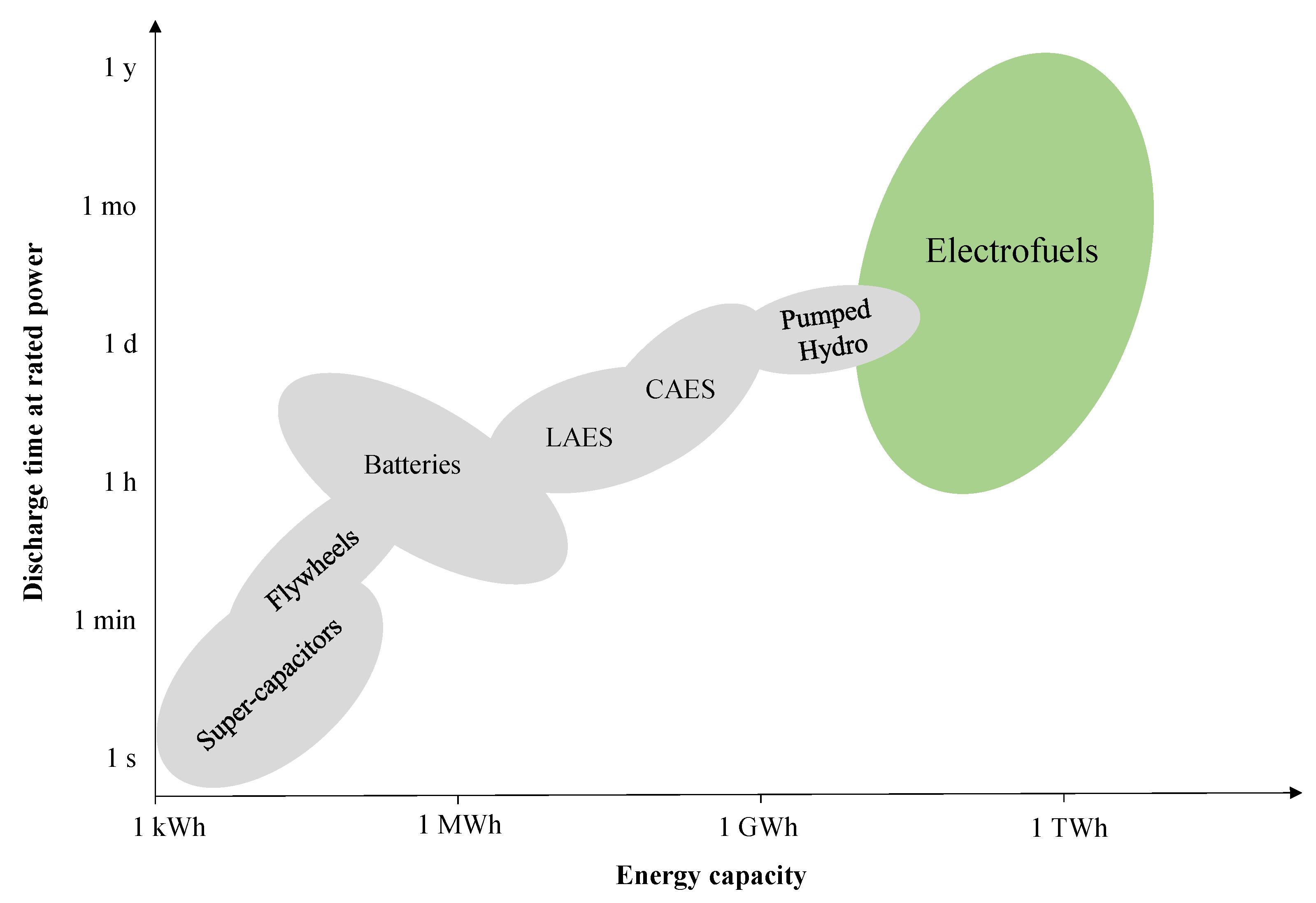

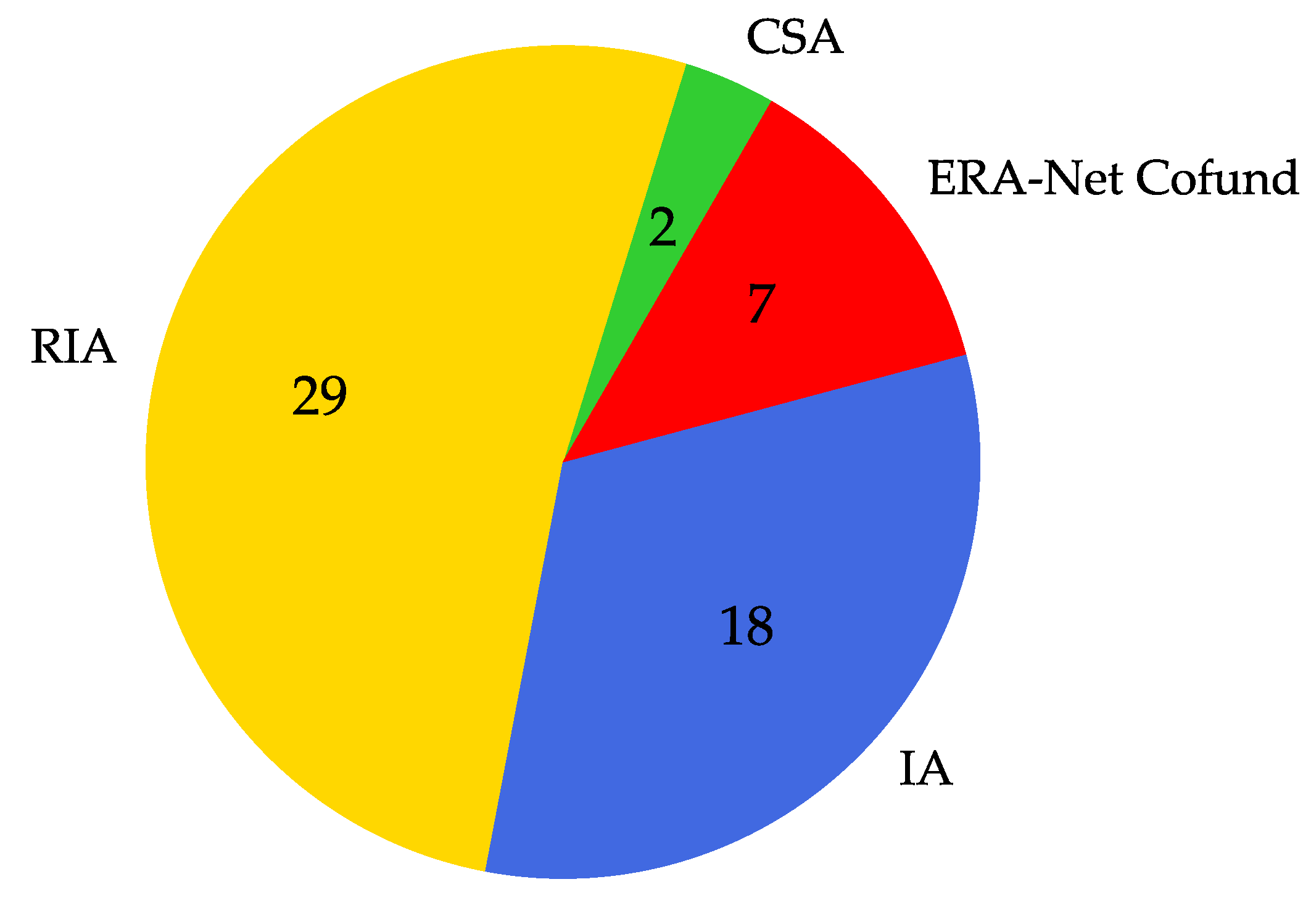

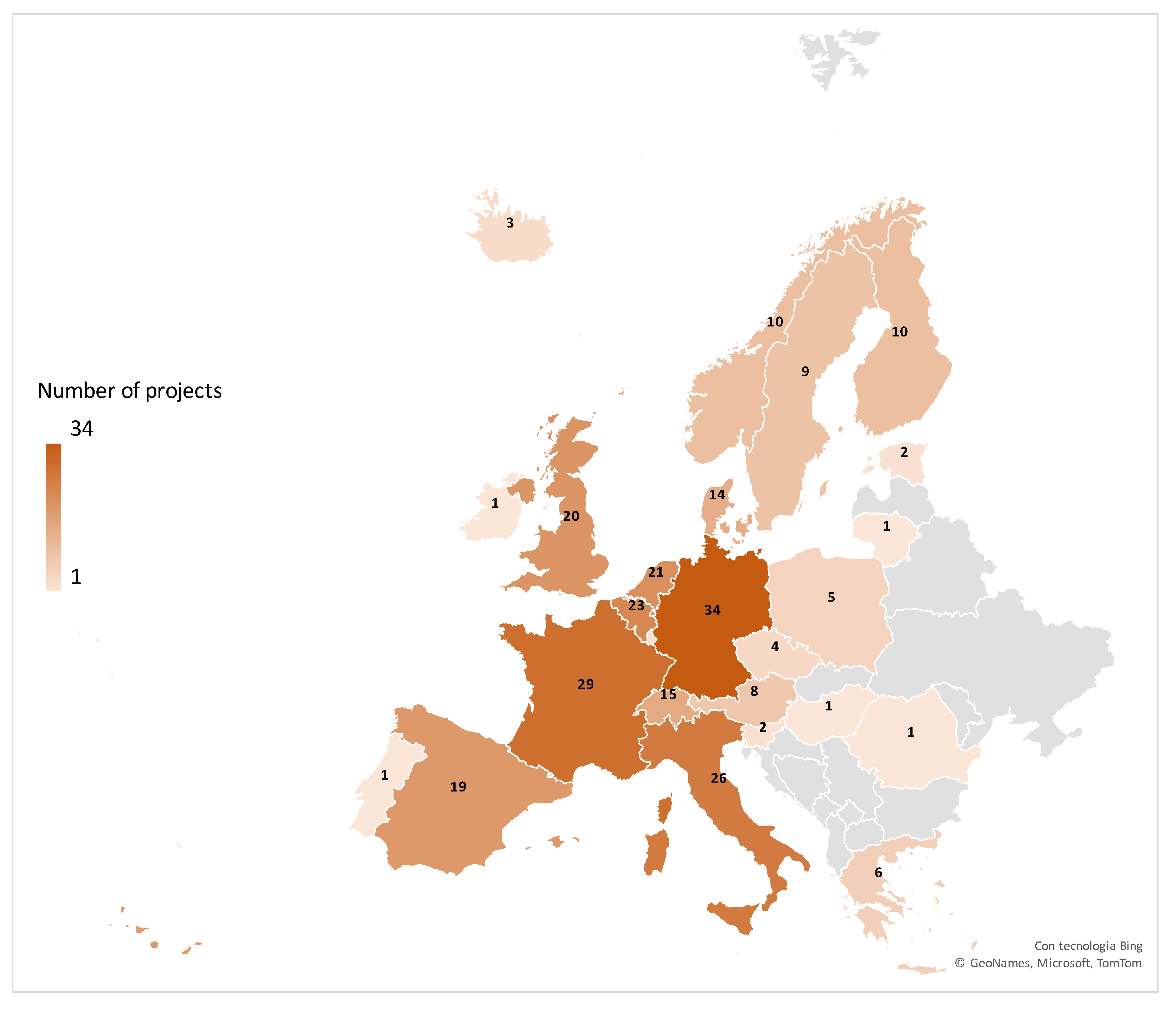

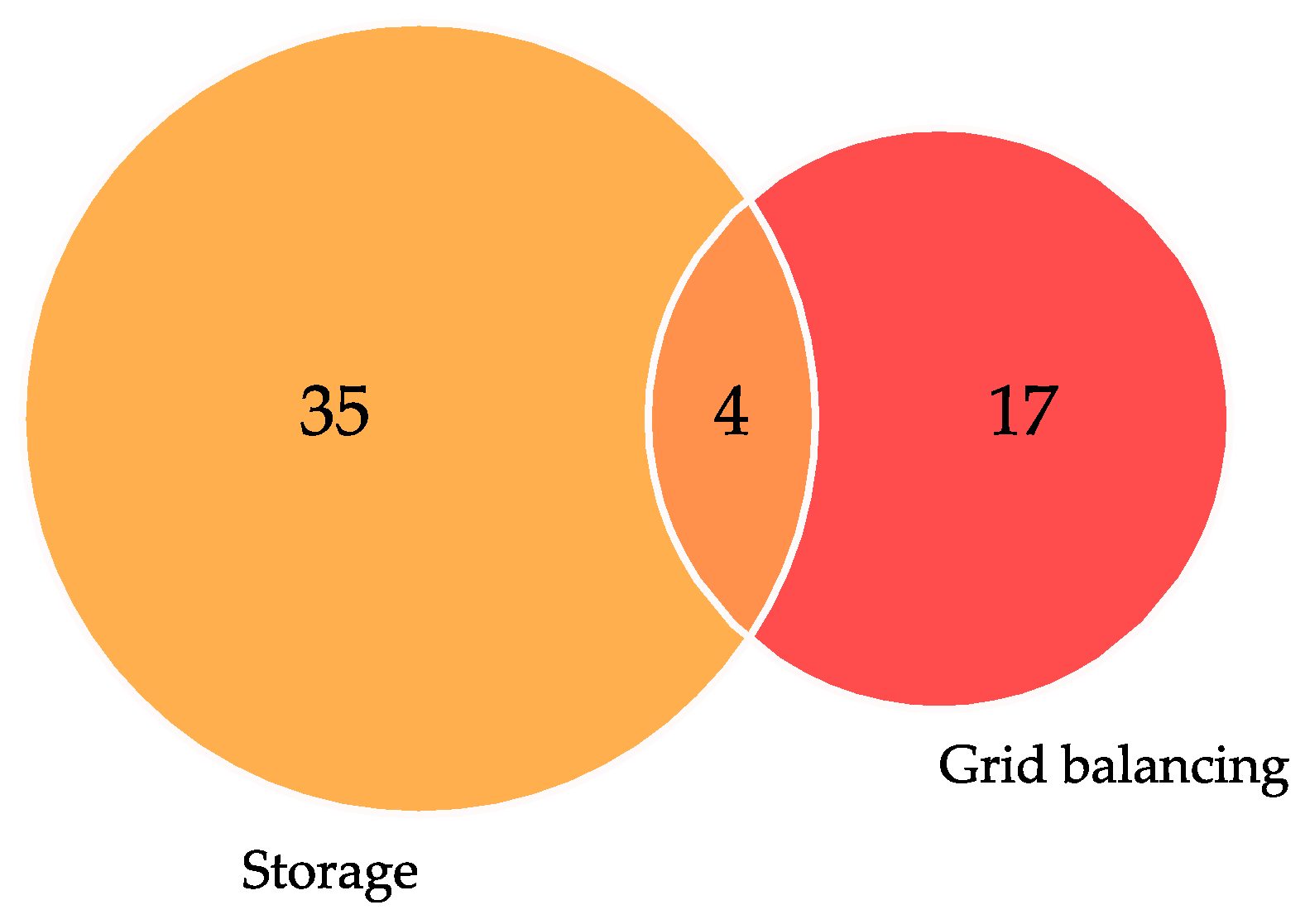

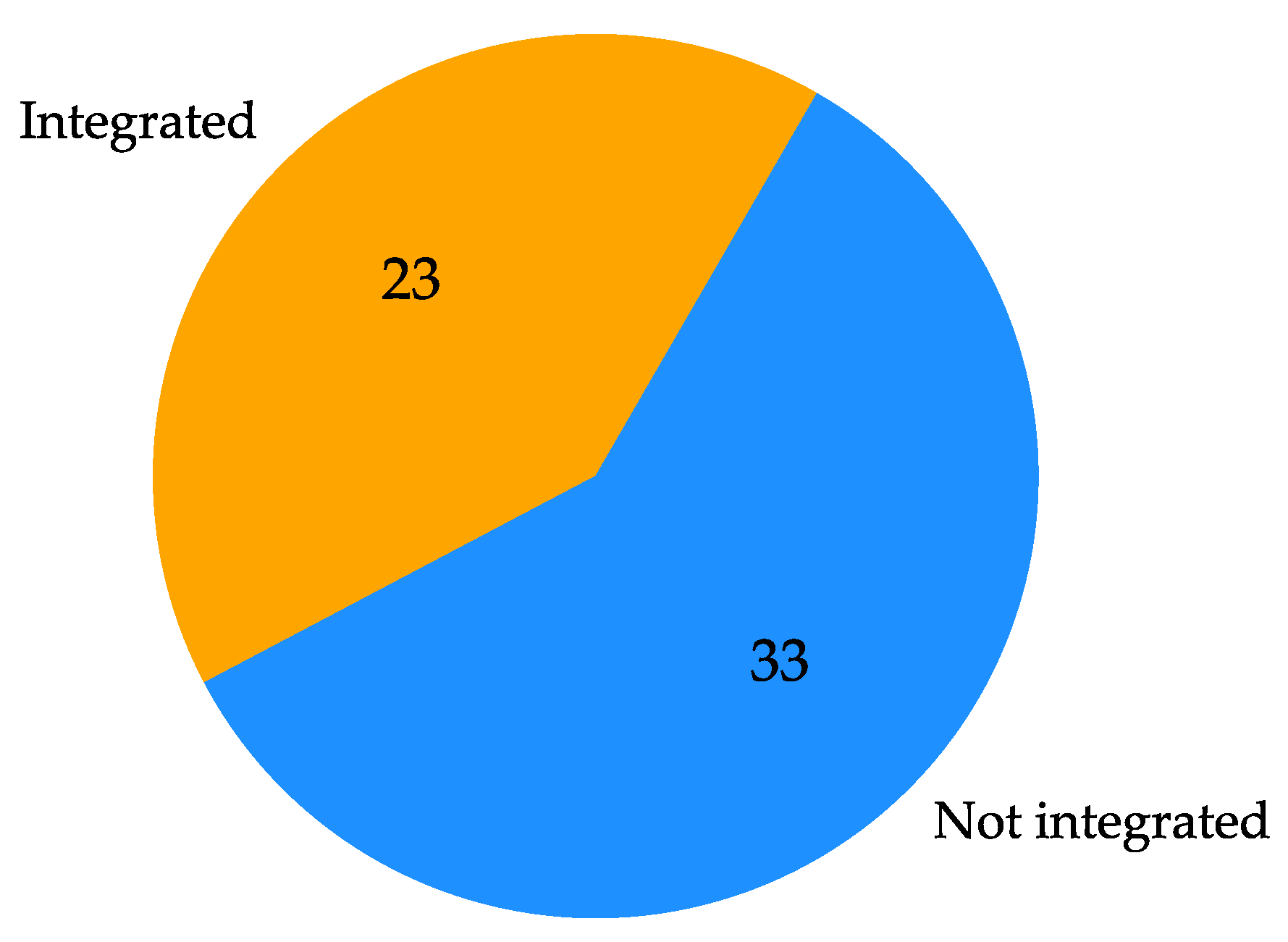
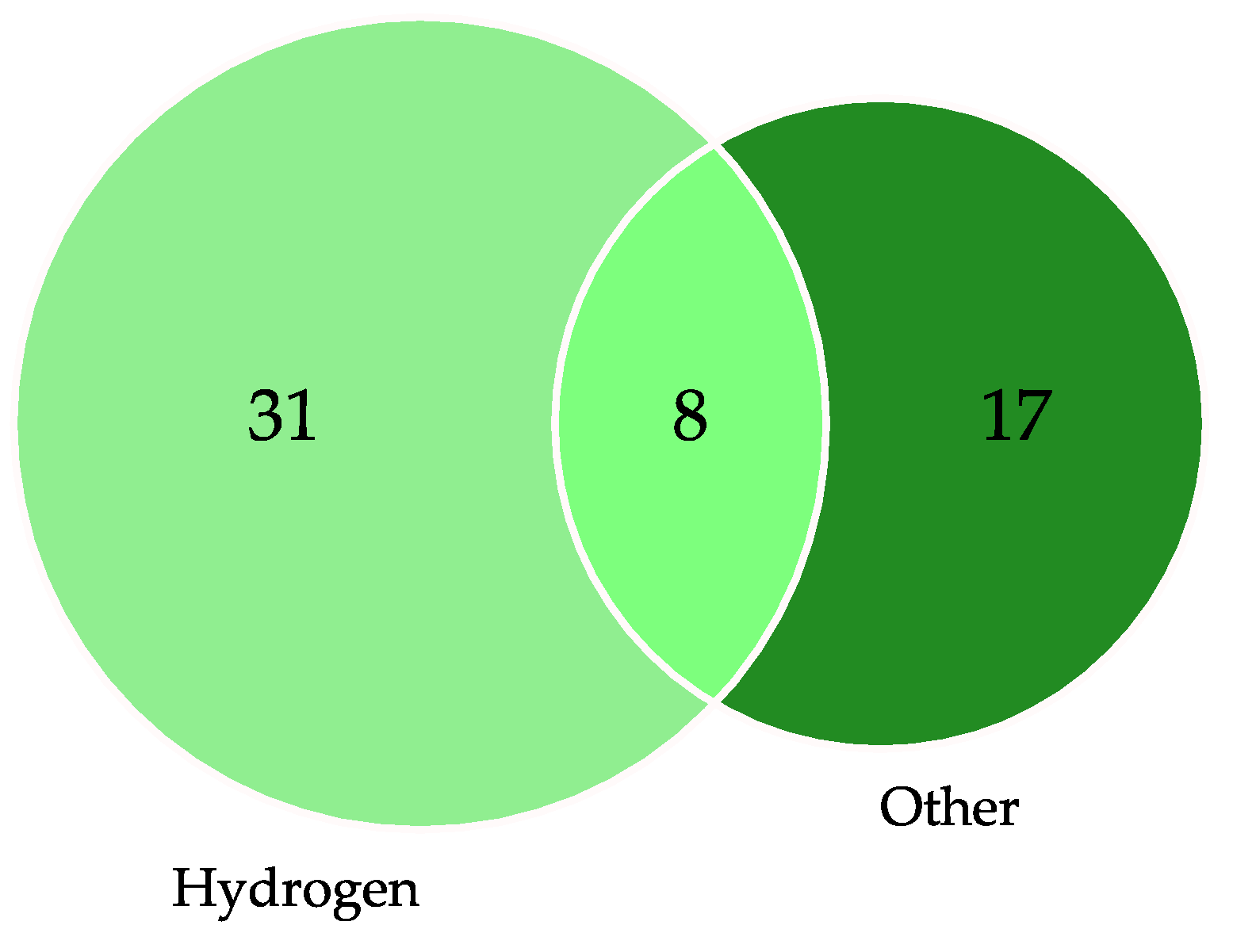
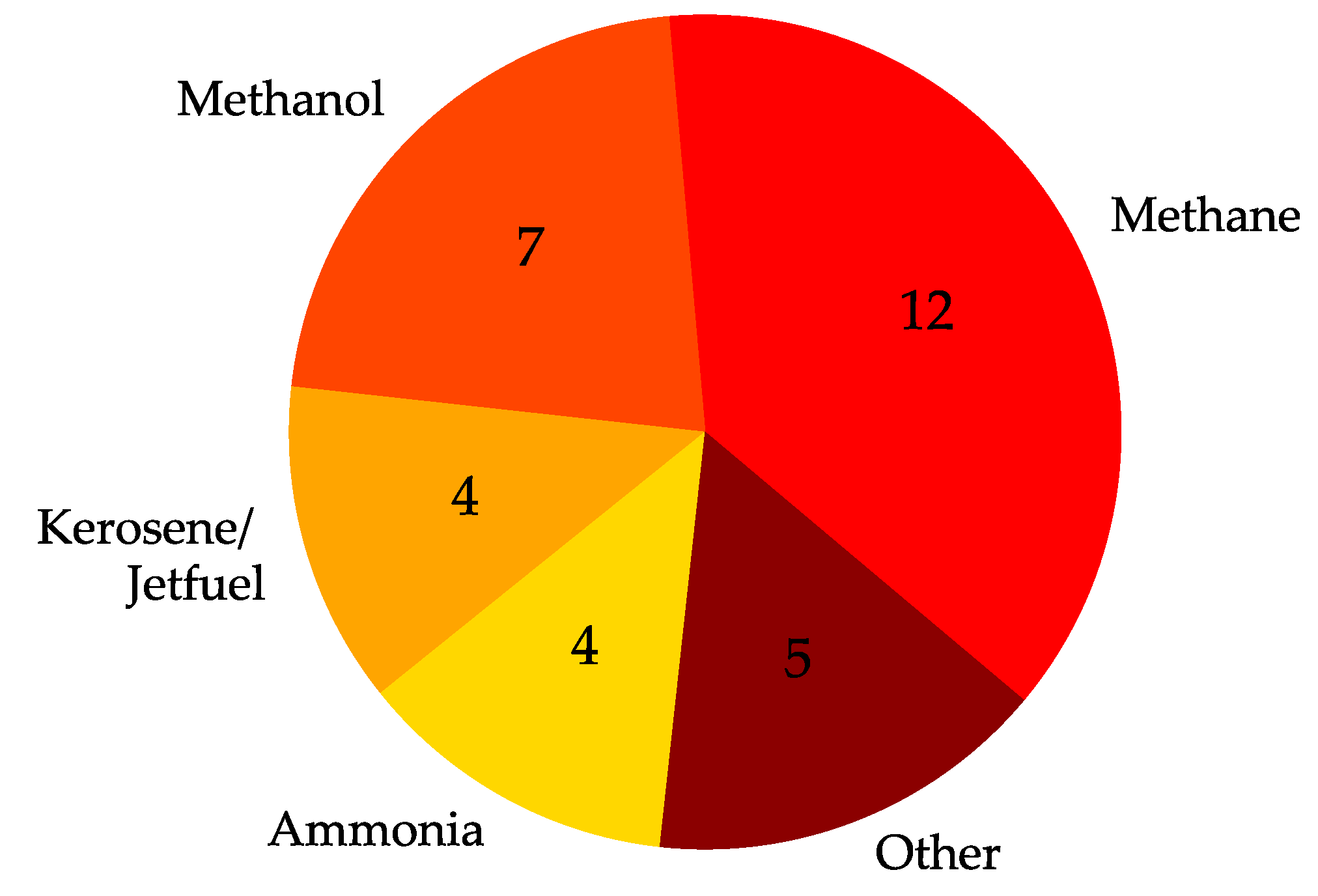

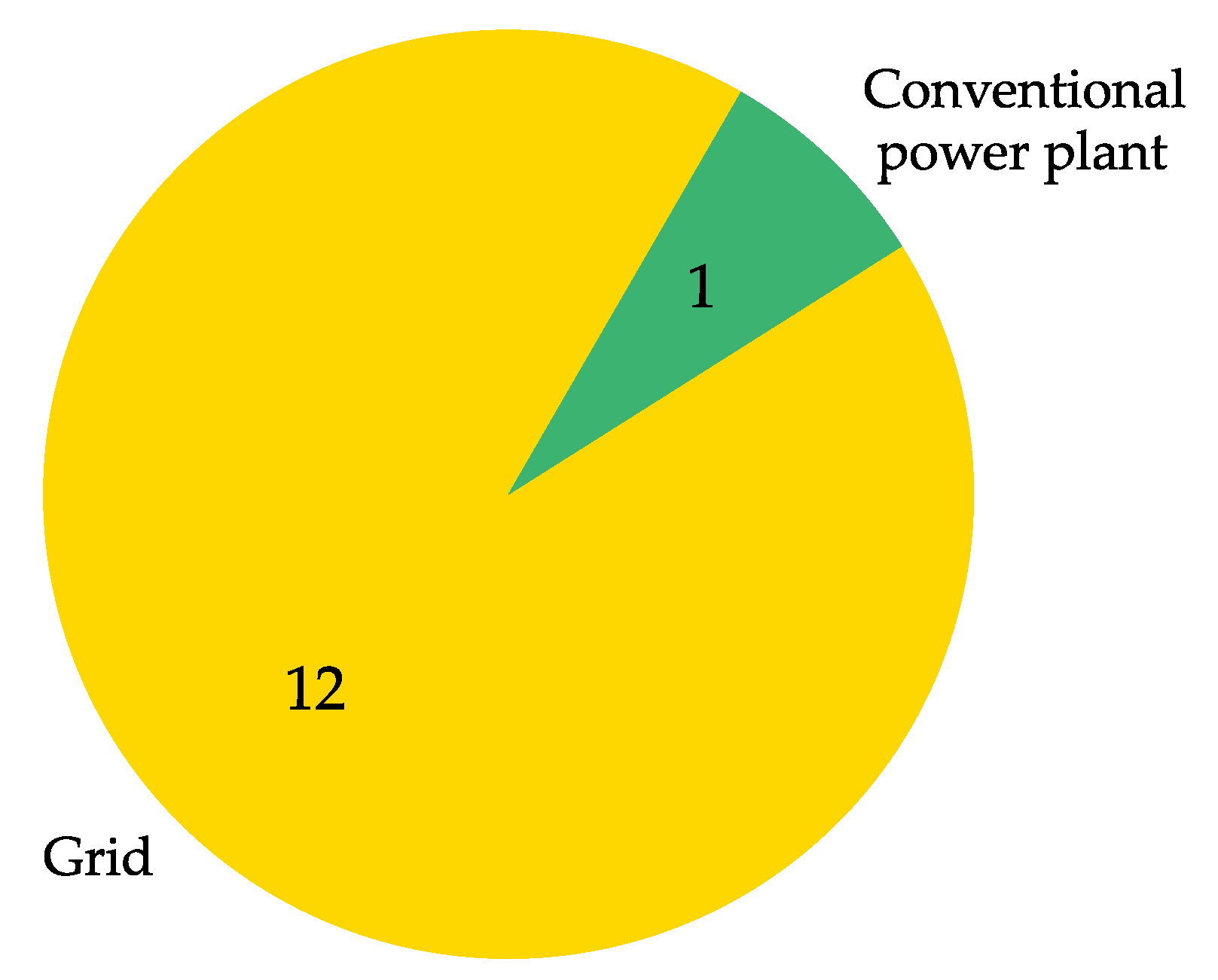
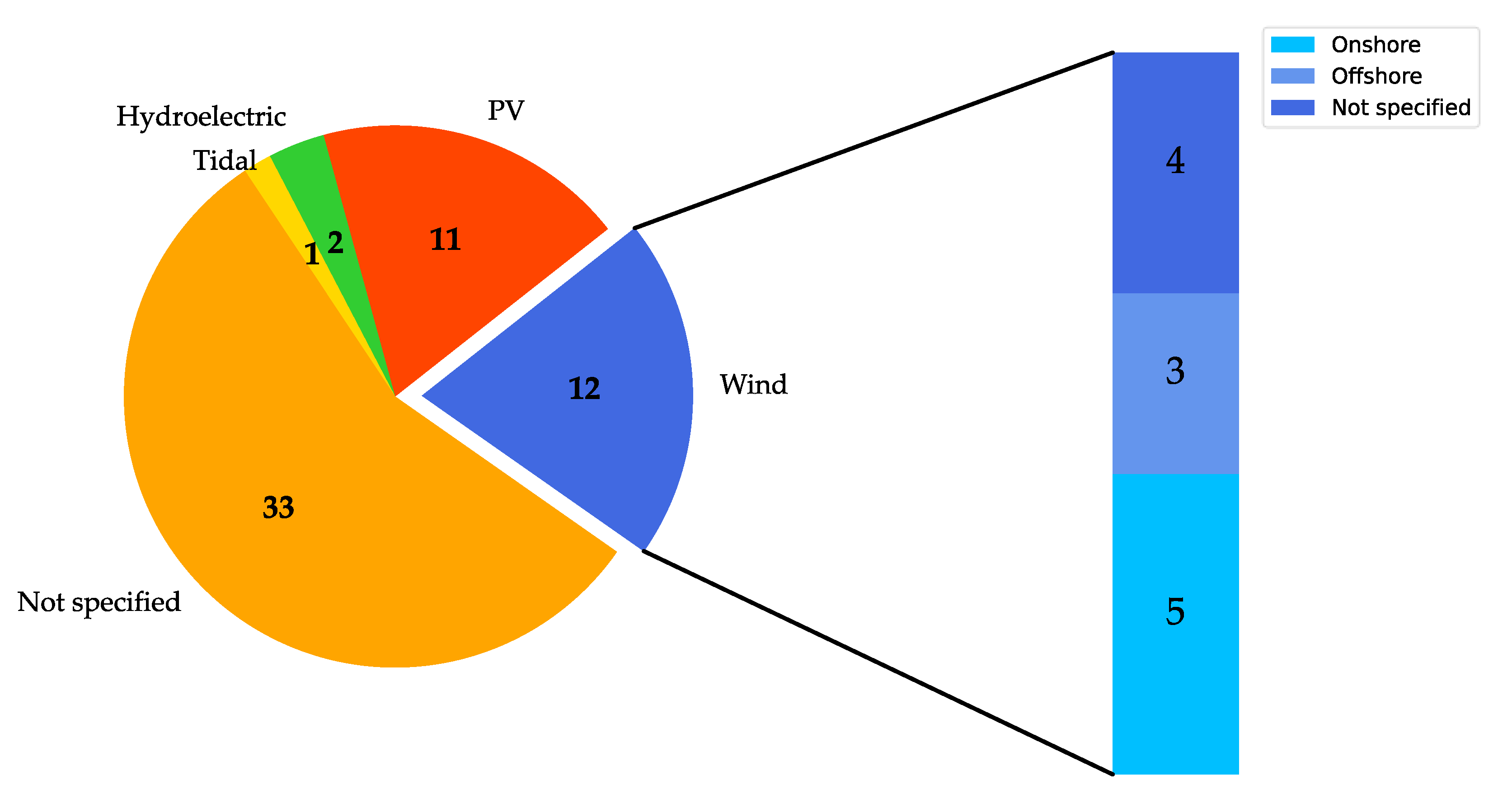
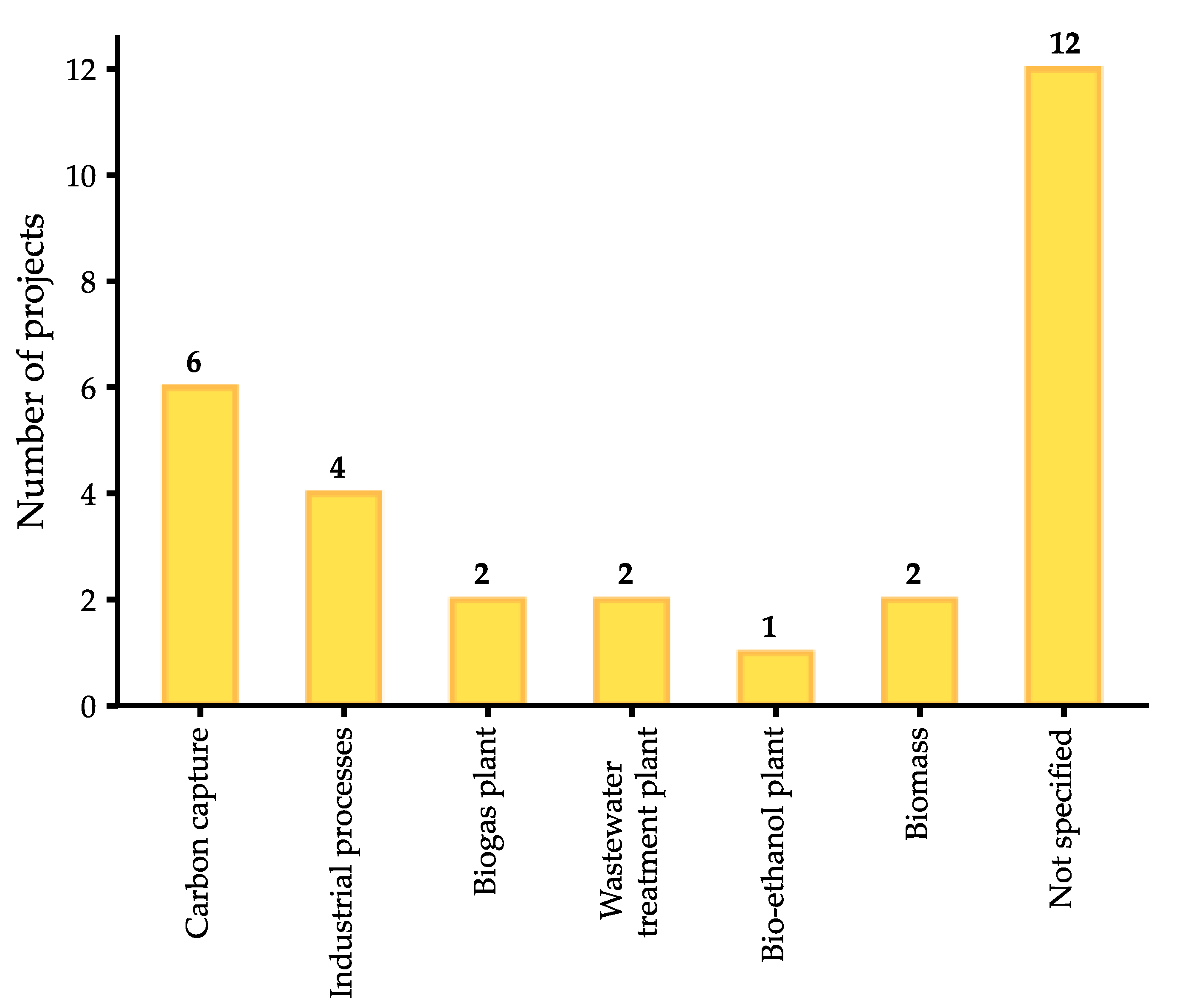
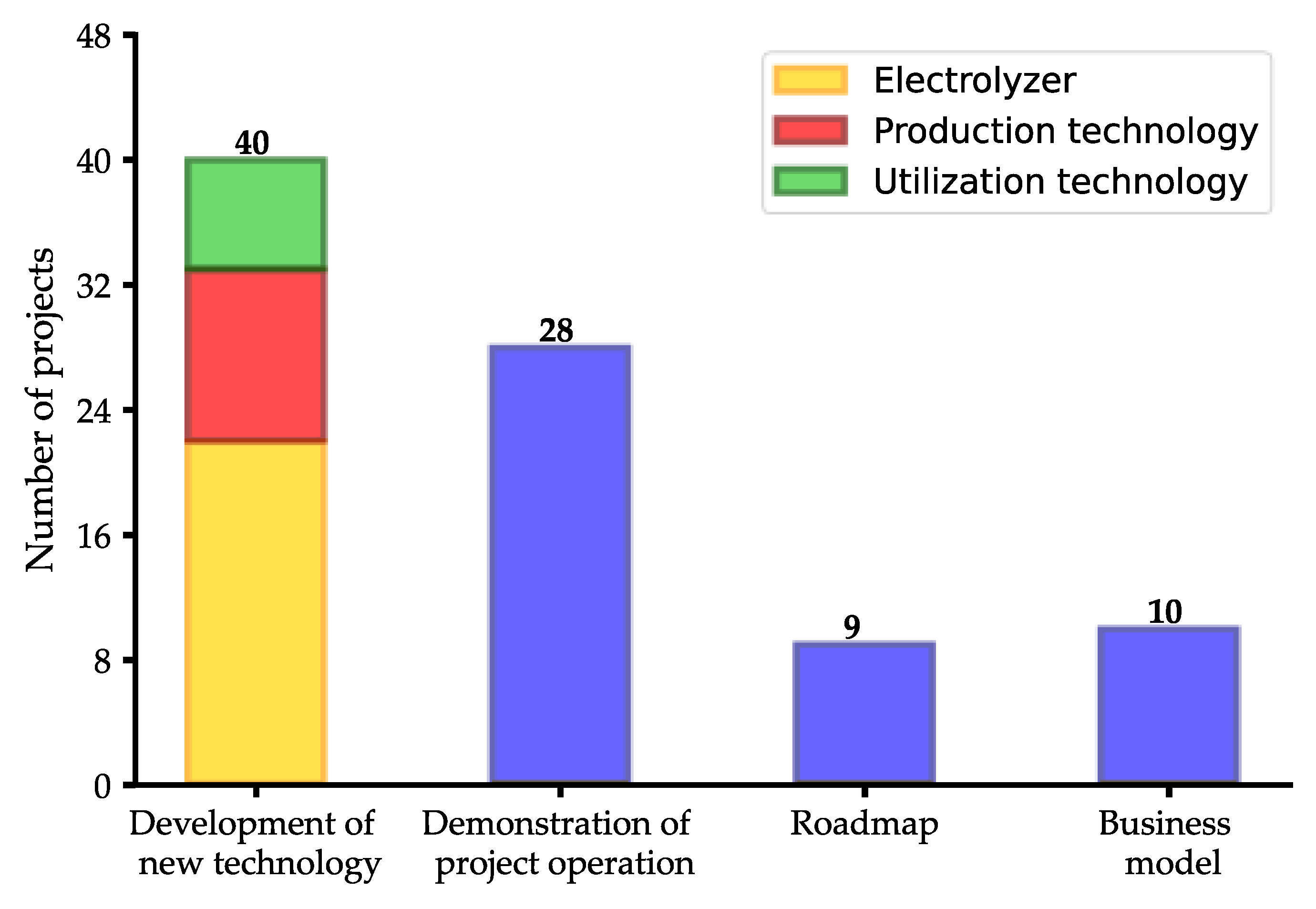
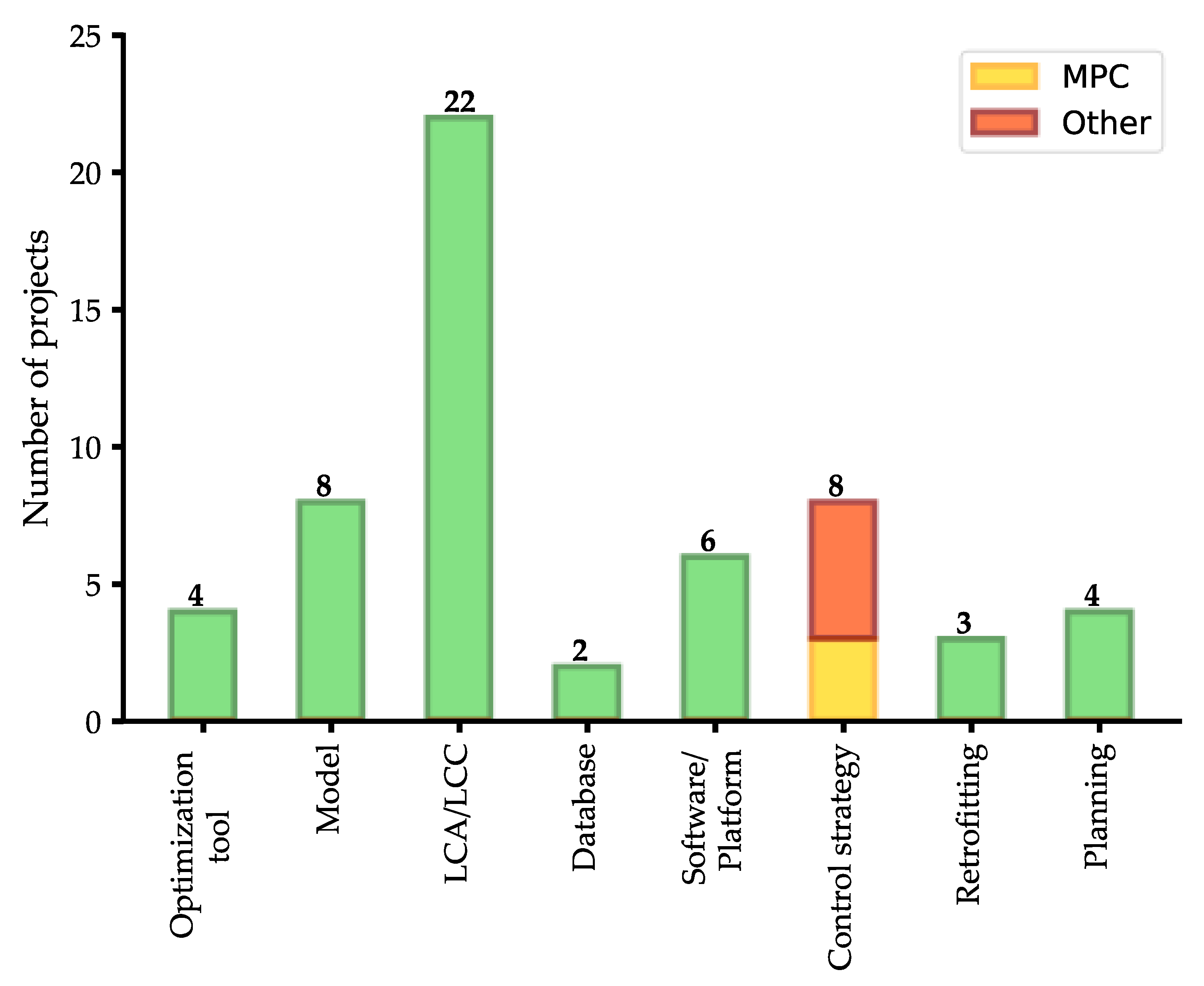

| AEC (Alkaline Electrolysis Cell) | PEM (Proton Exchange Membrane) | AEM (Anion Exchange Membrane) | SOEC (Solid Oxide Electrolysis Cell) | PCEC (Proton Ceramic Electrolysis Cell) | |
|---|---|---|---|---|---|
| State of development | Mature | Mature | Under developing | Under developing | Research status |
| Electrolyte | Alkaline solution | Proton exchange ionomer | Anion exchange ionomer | Solid electrolyte | Ceramic solid electrolyte |
| Cell separator | Diaphragm | Electrolyte membrane | Electrolyte membrane | Electrolyte membrane | Ceramic membrane |
| Temperature [°C] | 65 to 100 [26] | 70 to 90 [26] | 50 to 70 [26] | 700 to 1000 [22] | 300 to 600 [24] |
| Advantages | Available for large plant sizes, low costs, long lifetime | High efficiency, high dynamics | Low costs, high dynamics | High efficiency, possible integration of waste heat | Dry hydrogen produced, low costs |
| Disadvantages | Low current density, low dynamics, corrosive environment | Expensive, low durability | Not mature technology, expensive, low durability | Expensive, low durability, corrosive environment, low dynamics | Not mature technology, low durability |
| Feature | Explanation | ||
|---|---|---|---|
| Aim of the production | Storage | The scope of electrofuel production is to store energy | |
| Grid balancing | The scope of electrofuel production is to balance the electricity grid | ||
| Final utilization of the electrofuel | This identifies the final utilization of the electrofuel (industrial processes, aviation, trucks/vehicles, marine, electricity, heating system, gas grid) | ||
| Integration | Integrated | The project is implemented in an existing plant or structure | |
| Not integrated | The project is not implemented in an existing plant or structure; instead, it is a stand-alone project | ||
| Type of electrofuel | This identifies the type of fuel produced in the project (H2, methane, methanol, kerosene/Jet fuel, ammonia, others) | ||
| Electricity source | This identifies the origin of the electricity used for the electrofuel production (wind, PV, hydroelectric, tidal, biomass-based, RES in general, conventional power plant, grid) | ||
| Carbon dioxide source | This identifies the origin of the CO2 used for the electrofuel production if involved in the project (carbon capture, industrial processes, biogas plant, wastewater treatment plant, bio-ethanol plant, biomass) | ||
| Aim of the project | Development of a new technology | The aim of the project is to develop new technology for the production or utilization of the electrofuel | |
| Demonstration of project operation | The activity aims to demonstrate the operation of the project | ||
| Roadmap | The aim of the activity is to draft a roadmap | ||
| Business model | The activity aims to create a new business model for the industrialization or exploitation of the concept | ||
| Other outcomes | Optimization tool | An optimization algorithm is implemented | |
| Model/Library | One of the outcomes of the project is a model or a library of models for the simulation of systems that involve the production of electrofuels | ||
| LCA/LCC | Life Cycle Analysis or Life Cycle Cost are performed | ||
| Database | One of the outcomes of the activity is the creation of a database | ||
| Software/Platform | One of the activities is the creation of a software package or a platform for researchers and industries | ||
| Control strategies | Other | The project includes the utilization of control strategies for monitoring the operation of the plant | |
| MPC | The Model Predictive Control strategy is used: the control is based on the future behavior of the system | ||
| Retrofitting | The purpose of the project is to evaluate the addition of innovative technologies or functions to an existing system | ||
| Planning | The purpose of the project is to perform long-term planning of the system | ||
Publisher’s Note: MDPI stays neutral with regard to jurisdictional claims in published maps and institutional affiliations. |
© 2022 by the authors. Licensee MDPI, Basel, Switzerland. This article is an open access article distributed under the terms and conditions of the Creative Commons Attribution (CC BY) license (https://creativecommons.org/licenses/by/4.0/).
Share and Cite
Marzi, E.; Morini, M.; Gambarotta, A. Analysis of the Status of Research and Innovation Actions on Electrofuels under Horizon 2020. Energies 2022, 15, 618. https://doi.org/10.3390/en15020618
Marzi E, Morini M, Gambarotta A. Analysis of the Status of Research and Innovation Actions on Electrofuels under Horizon 2020. Energies. 2022; 15(2):618. https://doi.org/10.3390/en15020618
Chicago/Turabian StyleMarzi, Emanuela, Mirko Morini, and Agostino Gambarotta. 2022. "Analysis of the Status of Research and Innovation Actions on Electrofuels under Horizon 2020" Energies 15, no. 2: 618. https://doi.org/10.3390/en15020618
APA StyleMarzi, E., Morini, M., & Gambarotta, A. (2022). Analysis of the Status of Research and Innovation Actions on Electrofuels under Horizon 2020. Energies, 15(2), 618. https://doi.org/10.3390/en15020618








